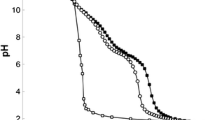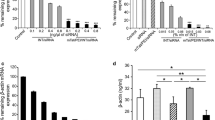Abstract
Polyethyleneimine (PEI) is a cost-effective and non-viral vector for gene transfer, but the factors determining gene transfer efficiency and cytotoxicity of PEI in different mammalian cell lines remain largely unknown. In the present study, three different cell lines were chosen for investigation. Using pEGFP DNA and PEI, 21.5, 29.2, and 92.1 % of GFP-positive cells were obtained in BMSC, Hela, and 293T, respectively. In luciferase reporter assay, similar results were obtained (for luciferase activity, BMSC < Hela < 293T cells). By MTT test and cell apoptotic marker analysis, we demonstrated that high gene transfer efficiency is accompanied with high cytotoxicity of PEI. Moreover, we found that high expression level of caveolin-1 was accompanied with high gene transfer efficiency and cytotoxicity of PEI in 293T cells. More convincingly, caveolin-1 silencing in 293T could reduce both gene transfer efficiency and cytotoxicity of PEI. In contrast, caveolin-1 overexpression in BMSCs increases both gene transfer efficiency and cytotoxicity of PEI. Taken together, our study suggests that caveolin-1 may at least in part determine gene transfer efficiency and cytotoxicity of PEI in mammalian cell lines, providing caveolin-1 as a potential target for improving gene transfer efficiency when applying positively charged polyplexes to cell transfection.





Similar content being viewed by others
References
Islam MA, Park TE, Singh B, Maharjan S, Firdous J, Cho MH, Kang SK, Yun CH, Choi YJ, Cho CS (2014) Major degradable polycations as carriers for DNA and siRNA. J Control Release S0168–3659:367–378
Zhao X, Cui H, Chen W, Wang Y, Cui B, Sun C, Meng Z, Liu G (2014) Morphology, structure and function characterization of PEI modified magnetic nanoparticles gene delivery system. PLoS One 9:e98919
Sou SN, Polizzi KM, Kontoravdi C (2013) Evaluation of transfection methods for transient gene expression in Chinese hamster ovary cells. Adv Biosci Biotechnol 6:1013–1019
Ehrhardt C, Schmolke M, Matzke A, Knoblauch A, Will C, Wixler V, Ludwig S (2006) Polyethylenimine, a cost-effective transfection reagent. Signal Transduct 6:179–184
Zaruc V, Weltin D, Erbacher P, Remy JS, Behr JP, Stephan D (2004) Effective polyethlenimine-mediated gene transfer into human endothelial cells. J Gene Med 6(2):176–184
Hsu CY, Uludağ H (2012) Cellular uptake pathways of lipid-modified cationic polymers in gene delivery to primary cells. Biomaterials 33(31):7834–7848
von Gersdorff K, Sanders NN, Vandenbroucke R, De Smedt SC, Wagner E, Ogris M (2006) The internalization route resulting in successful gene expression depends on both cell line and polyethylenimine polyplex type. Mol Ther 14(5):745–753
Rejman J, Bragonzi A, Conese M (2005) Role of clathrin- and caveolae-mediated endocytosis in gene transfer mediated by lipo- and polyplexes. Mol Ther 12(3):468–474
Rejman J, Conese M, Hoekstra D (2006) Gene transfer by means of lipo- and polyplexes: role of clathrin and caveolae-mediated endocytosis. J Liposome Res 16(3):237–247
Boussif O, Lezoualc’h F, Zanta MA, Mergny MD, Scherman D (1995) A versatile vector for gene and oligonucleotide transfer into cells in culture and in vivo: polyethylenimine. Proc Natl Acad Sci USA 92:7297–7301
Lai WF, Jung HS (2014) Cell Transfection with a β-cyclodextrin-PEI-propane-1,2,3-triol nanopolymer. PLoS One 9(6):e100258
Wang YQ, Su J, Wu F, Lu P, Yuan LF, Yuan WE, Sheng J, Jin T (2012) Biscarbamate cross-linked polyethylenimine derivative with low molecular weight, low cytotoxicity, and high efficiency for gene delivery. Int J Nanomed 7:693–704
Gosselin MA, Guo W, Lee RJ (2001) Synthesis, purification, and tumor cell uptake of 67 Ga-deferoxamine-folate, a potential radiopharmaceutical for tumor imaging. Bioconjug Chem 12(6):989–994
Li S, Dong W, Zong Y, Yin W, Jin G, Hu Q, Huang X, Jiang W, Hua ZC (2007) Polyethylenimine-complexed plasmid particles targeting focal adhesion kinase function as melanoma tumor therapeutics. Mol Ther 15(3):515–523
Liu Y, You R, Liu G, Li X, Sheng W, Yang J, Li M (2014) Antheraea pernyi silk fibroin-coated PEI/DNA complexes for targeted gene delivery in HEK 293 and HCT 116 cells. Int J Mol Sci 15(5):7049–7063
Nichols B (2003) Caveosomes and endocytosis of lipid rafts. J Cell Sci 116(Pt23):4707–4714
Fujimoto T, Kogo H, Nomura R, Une T (2000) Isoforms of caveolin-1 and caveolar structure. J Cell Sci 113(Pt 19):3509–3517
Pelkmans L, Helenius A (2002) Endocytosis via caveolae. Traffic 3:311–320
Fra AM, Williamson E, Simons K, Parton RG (1995) De novo formation of caveolae in lymphocytes by expression of VIP21-caveolin. Proc Natl Acad Sci USA 92:8655–8659
Yang HJ, Xia YY, Wang L, Liu R, Goh KJ, Ju PJ, Feng ZW (2011) A novel role for neural cell adhesion molecule in modulating insulin signaling and adipocyte differentiation of mouse mesenchymal stem cells. J Cell Sci 124(Pt15):2552–2560
Yun JH, Park SJ, Jo A, Kang JL, Jou I, Park JS, Choi YH (2011) Caveolin-1 is involved in reactive oxygen species-induced SHP-2 activation in astrocytes. Exp Mol Med 43(12):660–668
Tom R, Bisson L, Duroche Y (2008) Culture of HEK293-EBNA1 cells for production of recombinant proteins. Cold Spring Harb Protoc 3(4):pdb.prot4976
Ma D, Lin QM, Zhang LM, Liang YY, Xue W (2014) A star-shaped porphyrin-arginine functionalized poly(l-lysine) copolymer for photo-enhanced drug and gene co-delivery. Biomaterials 35(14):4357–4367
Yamano S, Dai J, Hanatani S, Haku K, Yamanaka T, Ishioka M, Takayama T, Yuvienco C, Khapli S, Moursi AM, Montclare JK (2014) Long-term efficient gene delivery using polyethylenimine with modified Tat peptide. Biomaterials 35(5):1705–1715
Florea BI, Meaney C, Junginger HE, Borchard G (2002) Transfection efficiency and toxicity of polyethylenimine in differentiated Calu-3 and nondifferentiated COS-1 cell cultures. AAPS PharmSci 4:E12
Durocher Y, Perret S, Kamen A (2002) High-level and high-throughput recombinant protein production by transient transfection of suspension-growing human 293-EBNA1 cells. Nucleic Acids Res 30:E9
Yamano S, Dai J, Hanatani S, Haku K, Yamanaka T, Ishioka M, Takayama T, Yuvienco C, Khapli S, Moursi AM, Montclare JK (2014) Long-term efficient gene delivery using polyethylenimine with modified Tat peptide. Biomaterials 35(5):1705–1715
Fagerholm S, Ortegren U, Karlsson M, Ruishalme I, Strålfors P (2009) Rapid insulin-dependent endocytosis of the insulin receptor by caveolae in primary adipocytes. PLoS One 4(6):e5985
Ning Y, Buranda T, Hudson LG (2007) Activated epidermal growth factor receptor induces integrin alpha2 internalization via caveolae/raft-dependent endocytic pathway. J Biol Chem 282(9):6380–6387
Razani B, Zhang XL, Bitzer M, von Gersdorff G, Böttinger EP, Lisanti MP (2001) Caveolin-1 regulates transforming growth factor (TGF)-beta/SMAD signaling through an interaction with the TGF-beta type I receptor. J Biol Chem 276(9):6727–6738
Oba M, Aoyagi K, Miyata K, Matsumoto Y, Itaka K, Nishiyama N, Yamasaki Y, Koyama H, Kataoka K (2008) Polyplex micelles with cyclic RGD peptide ligands and disulfide cross-links directing to the enhanced transfection via controlled intracellular trafficking. Mol Pharm 5(6):1080–1092
Acknowledgments
We acknowledge the financial supports by Xinxiang Medical University Intramural Science Fostering Foundation (contracts 2013ZD115 and 2013QZ107).
Conflict of interest
The authors declare that they have no conflict of interest.
Author information
Authors and Affiliations
Corresponding author
Rights and permissions
About this article
Cite this article
Yang, HJ., Feng, P., Wang, L. et al. Caveolin-1 mediates gene transfer and cytotoxicity of polyethyleneimine in mammalian cell lines. Mol Cell Biochem 402, 203–211 (2015). https://doi.org/10.1007/s11010-015-2328-z
Received:
Accepted:
Published:
Issue Date:
DOI: https://doi.org/10.1007/s11010-015-2328-z




